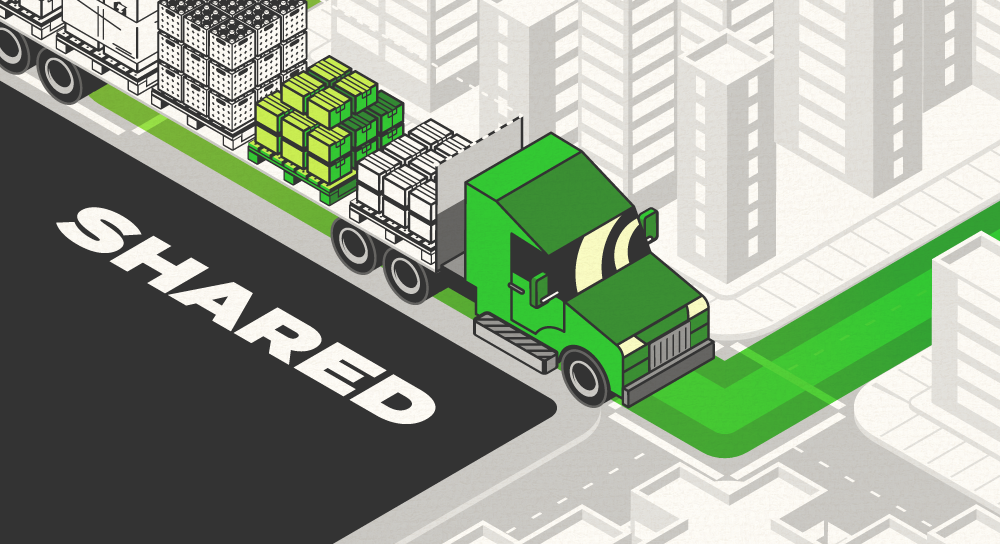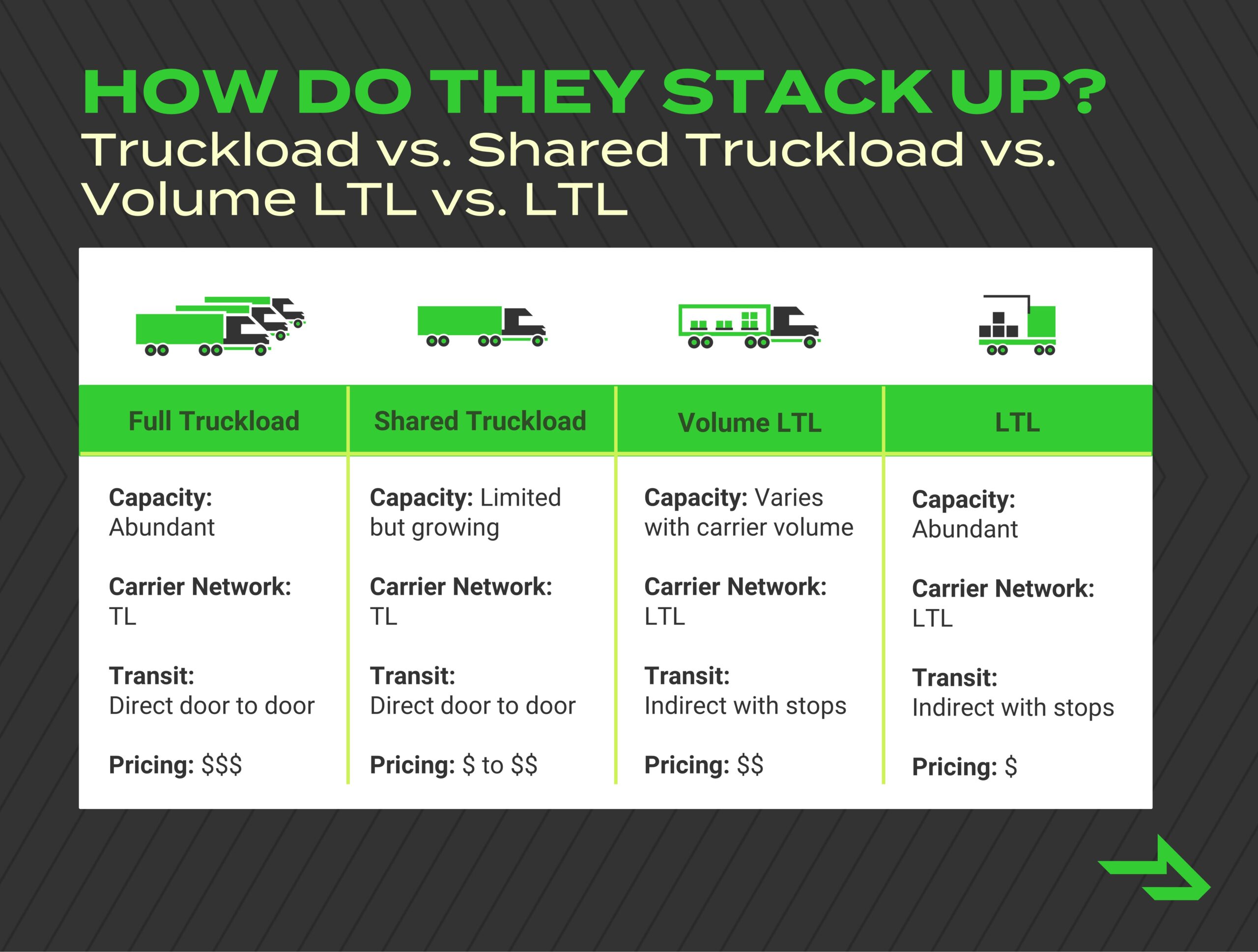Shared Truckload Explained: When to Use It, How to Find It & Why It’s Worth the Effort
Do you regularly book full truckload shipments that are a bit less than full?
Or do you find your less than truckload (LTL) shipments take longer and are less reliable than you’d like?
There’s good news: Your choice isn’t limited to the conventional one between full truckload and LTL.
You might be a great candidate to find efficiency, cost and sustainability benefits by shipping shared truckload.
Learn what shared truckload is, how it compares to the modes you’re used to shipping today and how to take advantage of its benefits.
Article Overview
Shared truckload, also called co-loading or partial truckload, is a method of combining multiple shippers' freight in a single trailer.
But the same can be said for LTL.
So what's the difference between these logistics modes of transportation?
How is Shared Truckload Different from LTL and Volume LTL?
LTL carriers use a very different operational model than truckload carriers. Their “hub and spoke” approach means that freight shipped with LTL carrier moves through a series of terminals where it gets unloaded from one truck and loaded onto another between the time it’s picked up and the time it arrives at its destination.
Volume LTL operates in the same manner; the biggest difference between standard and volume LTL is the number of pallets a carrier is willing to accept (typically a maximum of 6 for standard LTL and 12 for volume LTL.
Shared truckload skips all this operational complexity. When shipped via shared truckload, your freight will not stop at any consolidation hubs and it will not be transloaded at any point during its journey.
It will travel in a relatively straight shot, stopping only in the event that another shipper’s freight needs to be picked up or dropped off before yours reaches its destination.
How Is Shared Truckload Different From Full Truckload?
Operationally, a shared truckload shipment will look a lot like a full truckload one.
It will be picked up from your origin facility by a truckload carrier, loaded onto a truck and driven door-to-door to your destination facility.
The main difference? It will have company in the trailer from another shipper’s freight.
What Are the Benefits of Shared Truckload?
Compared to LTL (Standard or Volume):
- Faster service
- Less freight handling
- No stops at intermediary terminals
- More predictable delivery times
- More reliable tracking via truckload carrier
- Freight class not required
- Same price as your quoted LTL shipment
Compared to Full Truckload
- Potential price break compared to the cost of booking a full truck
- Contribute toward your company’s sustainability KPIs by reducing greenhouse gases by as much as 40%
Are There Any Drawbacks?
Really just one, but it’s significant — capacity.
While any of the 900,000 for-hire trucking companies out there could potentially run shared truckload, there simply aren’t yet many who are interested in doing it. Nor are there many 3PLs with the resources in place to make it happen regularly.
When Should You Use Shared Truckload?
You should consider shared truckload if you have an LTL or volume LTL shipment of 1 to 12 pallets, as you can enjoy the service and efficiency benefits of truckload shipping (shorter transit time, reliable pick-up/drop-off timing, minimal handling) at an LTL price point.
Conversely, you should consider converting your truckload freight to shared truckload if you have an underutilized trailer hauling freight without many unusual handling requirements on a high-value lane. You can potentially defray some of your costs and reduce your carbon footprint by sharing the load.
Getting Started With a Shared Truckload Provider
Today, shared truckload generally depends on a third-part logistics provider (3PL) to make a match between multiple shippers who are good candidates for the mode.
These matches rely on algorithms that pair shipments together that are good candidates to travel shared truckload. These can be multiple LTL shipments, underutilized truckloads or a mix of the two.
Volume isn’t the only factor at play, though. To be a strong shared truckload match, shipments need to align in terms of:
- Origin: Are pick-up locations close enough to not add too much time to the driver’s route?
- Destination: Are drop-off locations close enough as well?
- Transit time: Are you expecting similar pick-up and drop-off dates and times?
- Commodity type: Can your freight travel together? This is especially important for food shipments, very fragile freight and temperature controlled freight.
- Weight: Will your combined freight stay under the 45,000 lb. limit for a 53’ dry van trailer?
Given how tricky it can be to match two shippers with a willing carrier, it’s mostly up to you to be proactive about seeking out opportunities to ship shared truckload.
If you already work with a 3PL for your LTL or truckload freight, talk to your provider to see if they have the capability to help you procure shared truckload, then review your freight profile together to give yourself the best chance of finding a match.
Identify high-value lanes, see if you are often running underutilized truckloads or LTL shipments on them, and flag good candidates to track.
Shared truckload opportunities can often be fleeting. You want your provider to be looking out for them with your specific freight in mind, and you need to be ready to promptly give the OK to book.
Ask Us About Shipping Shared Truckload
If you’re interested in realizing service and efficiency gains for your LTL freight or cost and carbon emissions savings for your less-than-full truckloads, we’re happy to help.
Get in touch with our strategic capacity specialists to discuss your shared truckload options. We’re happy to help you review your freight and help you form a strategy to give yourself the best chance of finding a match.






